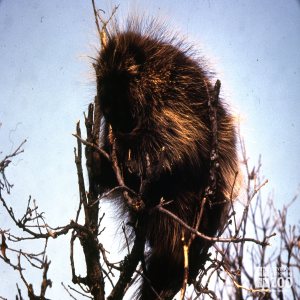North American Porcupine
[Erethizon dorsatum]

The North American Porcupine averages 3.5 feet in length, including a 6-inch tail, and can weigh up to 40 pounds. The upper body is covered with sharp quills nestled among long, thick fur ranging down the tail. The underside is covered with long, dark fur. The feet have a naked sole with 4 toes on the front feet and 5 toes on the hind feet.
Location: Education Animals
Share:
Range
The North American Porcupine's range includes Alaska, Canada, the United States. except the southeast quarter, and the extreme north of Mexico.
Habitat
North American Porcupines inhabit timbered and wooded areas.
Conservation Status
Least ConcernPrimary Threats
Gestation
Gestation is 7 months.
Litter
Usually 1
Behavior
North American Porcupine's are mainly nocturnal, and while foraging, continually sniff the air. They do not hibernate in the winter but will remain in the den during extreme cold or stormy weather. They are rarely known to attack but will defend themselves when attacked by climbing or fleeing. If cornered, they use the quilled tail for defense. Contrary to popular belief, they do not shoot these quills, but they back into the foe, causing the lightly-attached quills to detach themselves when entering the enemy's skin. They crave salt, and often gnaw at machinery, gloves, boots, saddles and bottles which have been touched by sweaty hands. Their predators are the wolverine, puma, and fisher-marten. Other carnivores will attack porcupines only as a last resort.
Reproduction
Mating of North American Porcupines occurs in the fall or early winter. The courtship consists of extensive vocalizing and a kind of dance. The young are born from April to June.
Wild Diet
Bark, evergreens, herbaceous plants, flowers, leaves
Zoo Diet
Apples, bananas, yams, monkey chow, vionate, cod liver oil
